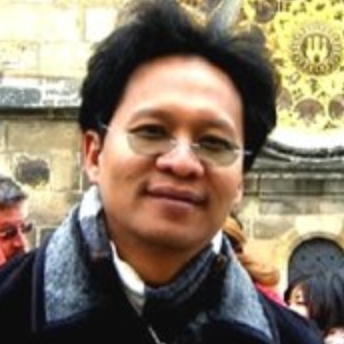International Journal of Intelligent Systems and Applications (IJISA)
IJISA Vol. 8, No. 11, 8 Nov. 2016
Cover page and Table of Contents: PDF (size: 1031KB)
Application of Intensified Current Search to Multiobjective PID Controller Optimization
Full Text (PDF, 1031KB), PP.51-60
Views: 0 Downloads: 0
Author(s)
Index Terms
Intensified Current Search, Multiobjective PID Controller, Metaheuristics, Control System Optimization
Abstract
The intelligent control system design has been changed from the conventional approach to the optimization framework solved by efficient metaheuristics. The intensified current search (ICS) has been recently proposed as one of the most powerful metaheuristics for solving optimization problems. The ICS, the latest modified version of the conventional current search (CS), possesses the memory list (ML) regarded as the exploration strategy and the adaptive radius (AR) and adaptive neighborhood (AN) mechanisms regarded as the exploitation strategy. The ML is used to escape from local entrapment caused by any local solution, while both AR and AN mechanisms are conducted to speed up the search process. In this paper, the application of the ICS to multiobjective PID controller design optimization for the three-phase induction motor (3-IM) speed control system is proposed. Algorithms of the ICS and its performance evaluation against multiobjective functions are presented. As simulation results, the ICS can provide very satisfactory solutions for all test functions and the 3-IM control application. Moreover, the simulation results of motor control application are confirmed by the experimental results based on dSPACE technology.
Cite This Paper
Auttarat Nawikavatan, Satean Tunyasrirut, Deacha Puangdownreong, "Application of Intensified Current Search to Multiobjective PID Controller Optimization", International Journal of Intelligent Systems and Applications (IJISA), Vol.8, No.11, pp.51-60, 2016. DOI:10.5815/ijisa.2016.11.06
Reference
[1]V. Zakian, Control Systems Design: A New Framework, Springer-Verlag, 2005.
[2]F. Glover and G. A. Kochenberger, Handbook of Metaheuristics, Kluwer Academic Publishers, Dordrecht, 2003.
[3]E. G. Talbi, Metaheuristics form Design to Implementation, John Wiley & Sons, Hoboken, 2009.
[4]D. T. Pham and D. Karaboga, Intelligent Optimisation Techniques, Springer, London, 2000.
[5]X. S. Yang, Engineering Optimization: An Introduction with Metaheuristic Applications, John Wiley & Sons, 2010.
[6]J. H. Holland, Adaptation in Natural and Artificial Systems, University of Michigan Press, Ann Arbor, Michigan, USA, 1975, re-issued by MIT Press, 1992.
[7]M. Dorigo, “Optimization, learning and natural algorithms,” Ph.D. thesis, Politecnico di Milano, Italie, 1992.
[8]D. Karaboga, “An idea based on honeybee swarm for numerical optimization,” Technical Report TR06, Erciyes University, Engineering Faculty, Computer Engineering Department, 2005.
[9]K. V. Price and R. Storn, “Differential evolution: a simple evolution strategy for fast optimization,” Dr. Dobb’s J., vol. 22(4), 1997, pp. 18–24.
[10]J. Kennedy and R. Eberhart, “Particle swarm optimization,” Proceedings of IEEE International Conference on Neural Networks, vol. 4, 1995, pp. 1942–1948.
[11]Z. W. Geem, Music-Inspired Harmony Search Algorithm: Theory and Applications, Springer, 2009.
[12]X. S. Yang, “Firefly algorithms for multimodal optimization”, Stochastic Algorithms: Foundations and Applications (SAGA 2009), Lecture Notes in Computer Sciences, vol. 5792, 2009, pp. 169 – 178.
[13]X. S. Yang and S. Deb, “Engineering optimisation by cuckoo search,” International Journal of Mathematical Modelling and Numerical Optimisation, vol. 1(4), 2010, pp. 330–343.
[14]X. S. Yang, “A new metaheuristic bat-inspired algorithm,” Nature Inspired Cooperative Strategies for Optimization (NISCO 2010) (Eds. J. R. Gonzalez et al.), Studies in Computational Intelligence, Springer Berlin, 284, Springer, 2010, pp. 65–74.
[15]S. Kirkpatrick, C. D. Gelatt and M. P. Vecchi, “Optimization by simulated annealing,” Science, vol. 220(4598), 1983, pp.671–680.
[16]F. Glover and M. Laguna, Tabu Search, Kluwer Academic Publishers, 1997.
[17]A. Sukulin and D. Puangdownreong, “A novel meta-heuristic optimization algorithm: current search,” The 11th WSEAS International Conference on Artificial Intelligence, Knowledge Engineering and Data Bases (AIKED '12), Cambridge, UK, 2012, pp.125–130.
[18]A. Sukulin and D. Puangdownreong, “Control synthesis for unstable systems via current search,” The 11th WSEAS International Conference on Artificial Intelligence, Knowledge Engineering and Data Bases (AIKED '12), Cambridge, UK, 2012, pp.131–136.
[19]A. Sukulin, D. Puangdownreong and S. Suwannarongsri, “Design of PID controllers for unstable systems using current search,” The 4th KKU International Engineering Conference 2012 (KKU-IENC 2012), 2012, pp.141–146.
[20]D. Puangdownreong, “Application of current search to optimum PIDA controller design,” Intelligent Control and Automation, vol. 3(4), 2012, pp. 303–312.
[21]D. Puangdownreong, “Current search: performance evaluation and application to DC motor speed control system design,” Intelligent Control and Automation, vol. 4(1), 2013, pp. 42–54.
[22]D. Puangdownreong and A. Sukulin, “Current search and applications in analog filter design problems,” Journal of Communication and Computer, vol. 9(9), 2012, pp. 1083–1096.
[23]S. Suwannarongsri, T. Bunnag and W. Klinbun, “Energy resource management of assembly line balancing problem using modified current search method,” International Journal of Intelligent Systems and Applications (IJISA), vol. 6(3), 2014, pp. 1 – 11.
[24]S. Suwannarongsri, T. Bunnag and W. Klinbun, “Optimization of energy resource management for assembly line balancing using adaptive current search,” American Journal of Operations Research, vol. 4(1), 2014, pp. 8–21.
[25]S. Suwannarongsri, T. Bunnag and W. Klinbun, “Traveling transportation problem optimization by adaptive current search method,” International Journal of Modern Education and Computer Science, vol. 6(5), 2014, pp. 33–45.
[26]A. Nawikavatan, S. Tunyasrirut and D. Puangdownreong, “Application of intensified current search to optimum PID controller design in AVR system,” Lecture Notes in Computer Science, 2014, pp. 255–266.
[27]A. Nawikavatan, S. Tunyasrirut and D. Puangdownreong, “Optimal PID controller design for three-phase induction motor speed control by intensified current search,” The 19th International Annual Symposium on Computational Science and Engineering (ANSCSE19), 2015, pp.104–109.
[28]C. Thammarat, D. Puangdownreong, A. Nawikavatan and S. Tunyasrirut, “Multiobjective optimization of PID controller of three-phase induction motor speed control using intensified current search,” Global Engineering & Applied Science Conference 2015, 2015, pp. 82–90.
[29]D-N. Le, “Improving genetic algorithm to solve multi-objectives optimal of upgrading infrastructure in NGWN,” International Journal of Intelligent Systems and Applications (IJISA), vol. 5(12), 2013, pp.53-63.
[30]S. S. Rao, Engineering Optimization: Theory and Practice, John Wiley & Sons, 2009.
[31]C. L. Hwang and A.S.M. Masud, Multiple Objective Decision Making: Methods and Applications, Springer-Verlag, Berlin, 1979.
[32]S. S. Rao and H. R. Eslampour, “Multistage multiobjective optimization of gearboxes,” ASME Journal of Mechanisms, Transmissions, and Automation in Design, vol. 108, 1986, pp. 461–468.
[33]J. D. Schaffer, “Multiple objective optimization with vector evaluated genetic algorithms,” The 1st International Conference on Genetic Algorithms, 1985, pp. 93–100.
[34]K. Deb, A. Pratap, S. Agarwal and T. Mayarivan, “A fast and elitist multiobjective algorithm: NSGA-II,”IEEE Transactions on Evolutionary Computation, vol. 6, 2002, pp. 182–197.
[35]T. Robicˇ and B. Filipicˇ, “DEMO: differential evolution for multiobjective optimization,”Lecture Notes in Computer Sciences, vol. 3410(2005), 2005, pp. 520–533.
[36]X. S. Yang and S. Deb, “Multiobjective cuckoo search for design optimization,” Computers & Operations Research, vol. 40, 2013, pp. 1616–1624.
[37]D. Puangdownreong, “Multiobjective multipath adaptive tabu search for optimal PID controller design,” International Journal of Intelligent Systems and Applications (IJISA), vol. 7(8), 2015, pp. 51–58, 2015.
[38]H. Ghiasi, D. Pasini and L. Lessard, “A non-dominated sorting hybrid algorithm for multi-objective optimization of engineering problems,” Engineering Optimization, vol. 43(1), 2011, pp. 39–59.
[39]E. Zitzler and L. Thiele, “Multiobjective evolutionary algorithms: a comparative case study and the strength Pareto approach,” IEEE Transactions on Evolutionary Computation, vol. 3, 1999, pp.257–271.
[40]E. Zitzler, K. Deb, and L. Thiele, “Comparison of multiobjective evolutionary algorithms: empirical results,” Evolution Computing, vol. 8, 2000, pp.173–195.
[41]K. Ogata, Modern Control Engineering, Prentice Hall, New Jersey, 2010.
[42]R. C. Dorf and R. H. Bishop, Modern Control Systems, Prentice Hall, Upper Saddle River, New Jersey, 2005.
[43]N. Quijano, K. Passino and S. Jogi, A Tutorial Introduction to Control Systems Development and Implementation with dSPACE, Dept. of Electrical Engineering, The Ohio State University, 2002.
[44]http://www-personal.umich.edu/~aghaffar/dSPACE_ tutorial .pdf, access on 31 March, 2016.


